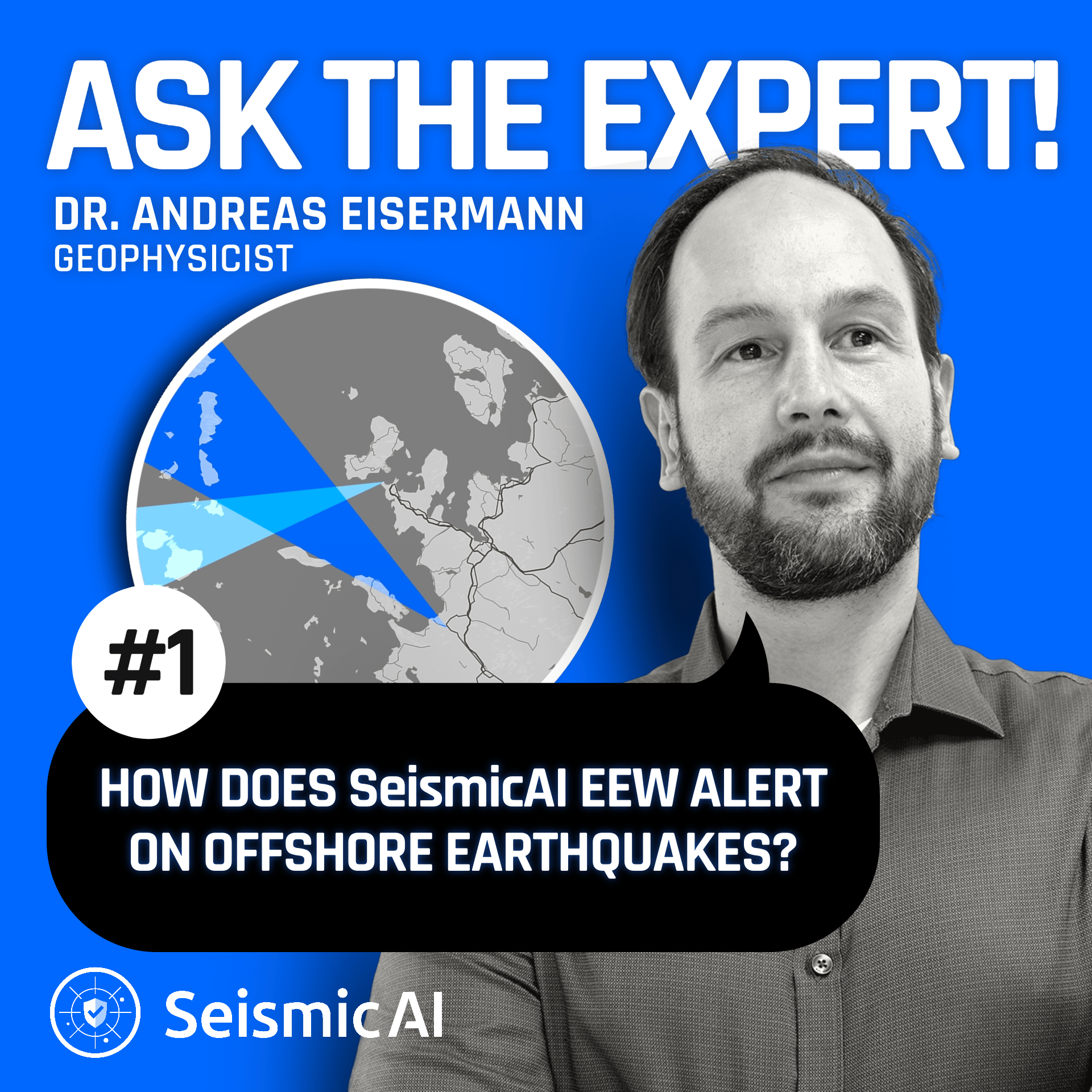Ask the Expert #1: How does SeismicAI EEW alert on offshore earthquakes?


Featuring: Dr. Andreas Samuel Eisermann, a Seismologist at SeismicAI, who holds a doctorate from Universität Stuttgart Institute of Geophysics, and a post-doctorate from Tel Aviv University, where he headed the Real-Time Seismology Laboratory.
Over 80% of large earthquakes occur near the Pacific Ocean, often causing tsunamis and destroying nearby communities and critical facilities. How does SeismicAI Earthquake Early Warning (EEW) system detect and alert on offshore earthquakes?
Detection of the precise location of the earthquake is critical for calculating the effect on each location. With traditional systems, in areas outside the seismic network, the precision of the earthquake’s location drops quickly as the distance from the network grows – and distance errors cause magnitude errors and distort the regional Predicted Ground Shaking (PGA).
SeismicAI’s regional algorithm utilizes arrays (local clusters of four sensors) that enable accurate identification of earthquake locations anywhere in the world, including offshore. SeismicAI’s Array seismology provides back azimuth information as well as S-phase triggering, which are much stronger constraints for the location than data obtained from standard single-sensor seismic networks.
Moreover, Arrays allow us to locate the earthquake much faster, using only two stations, hence providing an earthquake early alert with more warning time.
Learn more about SeismicAI Real-Time Seismology
Follow @seismicai on LinkedIn & stay tuned for our next “Ask the Expert”!
| Cookie | Duration | Description |
|---|---|---|
| cookielawinfo-checkbox-advertisement | 1 year | Set by the GDPR Cookie Consent plugin, this cookie is used to record the user consent for the cookies in the "Advertisement" category . |
| cookielawinfo-checkbox-analytics | 11 months | This cookie is set by GDPR Cookie Consent plugin. The cookie is used to store the user consent for the cookies in the category "Analytics". |
| cookielawinfo-checkbox-functional | 11 months | The cookie is set by GDPR cookie consent to record the user consent for the cookies in the category "Functional". |
| cookielawinfo-checkbox-necessary | 11 months | This cookie is set by GDPR Cookie Consent plugin. The cookies is used to store the user consent for the cookies in the category "Necessary". |
| cookielawinfo-checkbox-others | 11 months | This cookie is set by GDPR Cookie Consent plugin. The cookie is used to store the user consent for the cookies in the category "Other. |
| cookielawinfo-checkbox-performance | 11 months | This cookie is set by GDPR Cookie Consent plugin. The cookie is used to store the user consent for the cookies in the category "Performance". |
| elementor | never | This cookie is used by the website's WordPress theme. It allows the website owner to implement or change the website's content in real-time. |
| viewed_cookie_policy | 11 months | The cookie is set by the GDPR Cookie Consent plugin and is used to store whether or not user has consented to the use of cookies. It does not store any personal data. |
| Cookie | Duration | Description |
|---|---|---|
| _ga | 2 years | The _ga cookie, installed by Google Analytics, calculates visitor, session and campaign data and also keeps track of site usage for the site's analytics report. The cookie stores information anonymously and assigns a randomly generated number to recognize unique visitors. |
| _ga_FMPZCLWCH4 | 2 years | This cookie is installed by Google Analytics. |
| CONSENT | 2 years | YouTube sets this cookie via embedded youtube-videos and registers anonymous statistical data. |
| Cookie | Duration | Description |
|---|---|---|
| muc_ads | 2 years | Twitter sets this cookie to integrate and share features for social media and also store information about how the user uses the website, for tracking and targeting. |
| personalization_id | 2 years | Twitter sets this cookie to integrate and share features for social media and also store information about how the user uses the website, for tracking and targeting. |
| VISITOR_INFO1_LIVE | 5 months 27 days | A cookie set by YouTube to measure bandwidth that determines whether the user gets the new or old player interface. |
| YSC | session | YSC cookie is set by Youtube and is used to track the views of embedded videos on Youtube pages. |
| yt-remote-connected-devices | never | YouTube sets this cookie to store the video preferences of the user using embedded YouTube video. |
| yt-remote-device-id | never | YouTube sets this cookie to store the video preferences of the user using embedded YouTube video. |